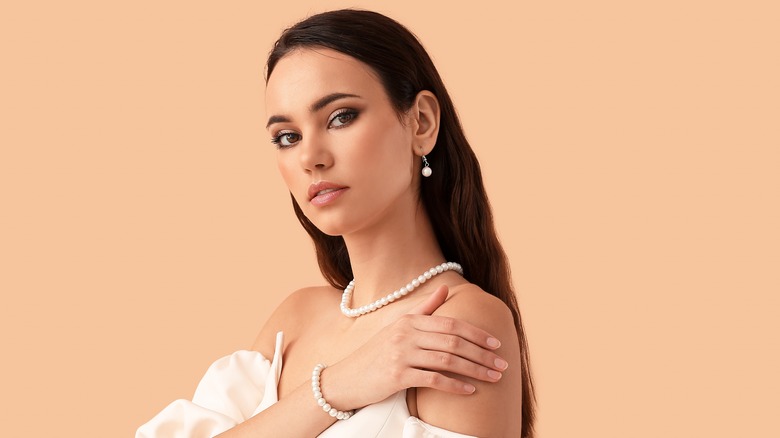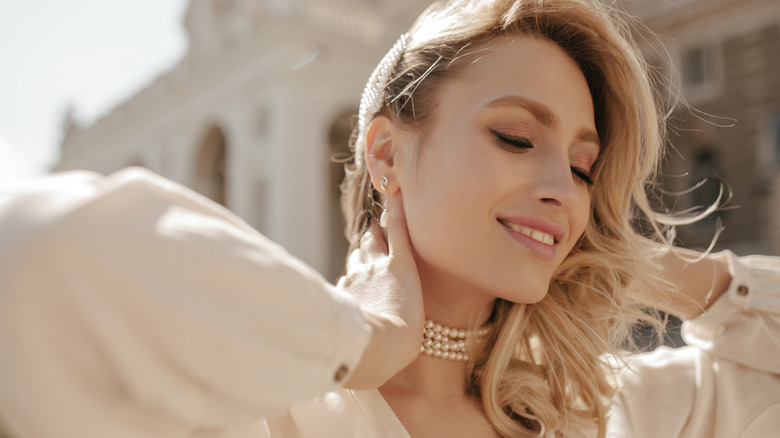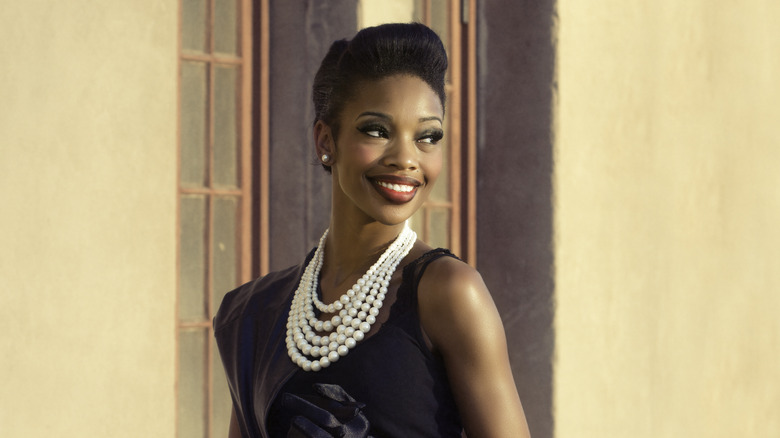Freshwater Vs. Natural Pearls: Which Is Best For Your Jewelry?
Pearls have long been associated with your grandmother's jewelry, but these days, there are many trendy options to choose from. While white or pink pearls are a classic look, make a fashion statement with black pearls that add a bit of edge to your outfit. Pearls can also be mixed and matched with other stones for a more colorful flair, making them one of the most versatile pieces of jewelry.
Whether you prefer the classic strand or like them combined with another gem, pearls will never go out of style, and they're a great investment for your collection. According to Pearl-Lang, pearls fall in the same fine jewelry category as diamonds, emeralds, rubies, and sapphires. The gem is known for its durability, which can last several lifetimes. A high-quality piece can be an heirloom that is passed down for generations.
When browsing jewelry stores, you may have noticed the many different types of pearls. While pearls are made from oysters, there are two environments in which they are created — freshwater and natural. The two processes are vastly different, and you may prefer one over the other.
Freshwater pearls are environmentally friendly and less expensive
If you're new to the pearl-buying world, you may want to consider freshwater or man-made stones. Freshwater pearls are grown on a farm in a controlled environment, Pearl Paradise explains. Instead of relying on fishing for oysters, farmers breed and grow their own until they're ready for nucleation. A foreign object is placed inside each oyster, which causes irritation, and eventually forms a pearl. Farmers can manipulate farmed oysters so that they can produce dozens of pearls, making the freshwater pearls cheaper than naturally-made gems.
With concerns growing about our ecosystem, many farmers take care to raise their oysters in a way that is as environmentally friendly as possible. They need to follow rules to ensure they're maintaining the natural habitat of the surrounding area, per The Bead Traders. Since oyster farming has become more regulated, ecosystems that have previously suffered are now recovering. Additionally, since freshwater pearls are more abundant, there is more variety to choose from. While some may look down on man-made pearls, they are still the real deal and worthy of investment. However, many covet natural pearls, but they're not so easy to come by these days.
Natural pearls are extremely rare and pricey
Natural or saltwater pearls are made organically by oysters and mollusks when an irritant works its way inside the shell, similar to freshwater pearls. As Love and Lavender explains, the oyster protects itself by forming layers of nacre, which is the substance pearls are made of.
Natural pearls were primarily harvested in the Arabian Gulf until the 1950s. However, with the abundance of cultivated pearls, the naturally made gems became less available. Most of the natural pearls these days are vintage and have exorbitant price tags.
If you do have the means to go natural, The Pearl Source suggests going to auctions, but be prepared to spend a lot of money. You can also find a retailer that carries natural pearls, but they may be hard to find. Before making a purchase, make sure the pearls come with an official certificate that proves their authenticity. While natural pearls may be more coveted, it's important to remember that they may not be as shiny and perfectly shaped as man-made pearls. However, as with any other natural gem, that's what makes them unique.
A look inside the different types of cultured pearls
While the most common pearls are white and round, they also come in many different shapes and colors. White and cream are the most common, but blue, purple, pink, and green varieties also exist, per GIA. Black, silver, and gray pearls are also popular and can look beautiful when mixed together.
There are four different types of cultured pearls. Akoya pearls are grown in the salt waters of Japan and China. These oysters produce perfectly white or cream pearls that you are used to seeing on strands. South Sea pearls are made in Australia, Indonesia, and the Philippines. These saltwater gems grow bigger than others and come in white and silver. Because of their size and luster, they tend to be the pricier of the lot. Tahitian pearls are made in the French Polynesian seas and come in a variety of colors. If you've seen someone with black, blue, green, or pink pearls, they are most likely wearing Tahitian-farmed varieties. Lastly, freshwater pearls are mainly farmed in China and are the most popular out of the four. They are also the most budget-friendly due to their abundance. With so many options to choose from, incorporating pearls into your outfits will be a snap.
How to accessorize any outfit with pearls
Pearls are no longer just for formal wear. In fact, many rely on the classic gem to elevate their daytime business attire or add elegance to a Sunday brunch outfit. If you're new to buying pearls, you might want to start off with a classic single-strand necklace, which you can pair with anything from a white tee and jeans or a cocktail dress. If you want a trendier look, try a multi-layered strand or colorful pearls. According to Add A Pearl, shorter necklaces are great for a casual look, while longer lengths provide a bit more glamour.
Remember, pearls don't have to be just for your neckline. You can opt for stud earrings or choose a dangly set for a special occasion. Pearl rings are also great pieces to incorporate into your jewelry collection. However, don't overload yourself with pearls, as it can look too overwhelming.
Mixing pearls with other jewelry such as gold or silver pieces will add a more modern flair. Cult of Sun suggests layering a pearl necklace with chunky gold chains. You can add several necklaces of different lengths to provide a layered effect, or ditch the perfectly shaped round pearls and go for ones that have a funky shape. Uneven cultured pearls can look naturally made without leaving a dent in your wallet. The modern take on pearls is that you can go as classic or as bold as you want.




